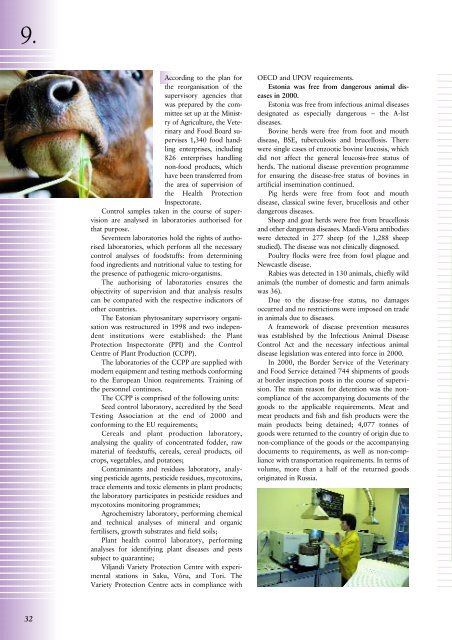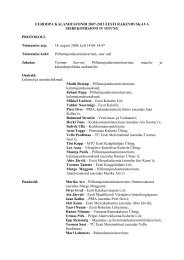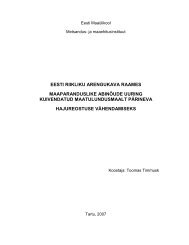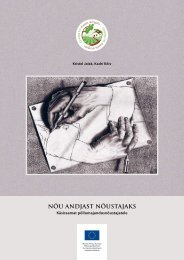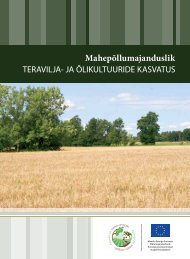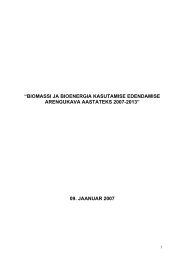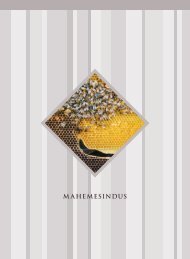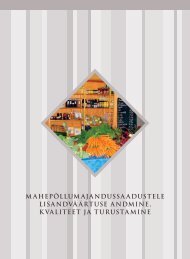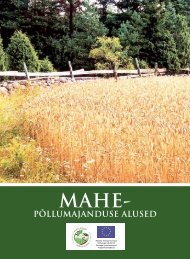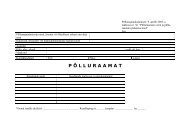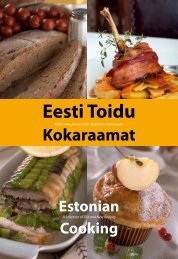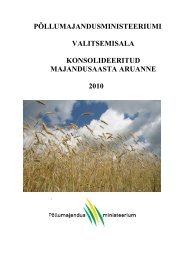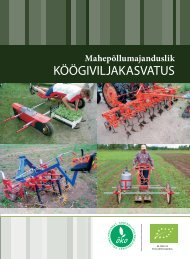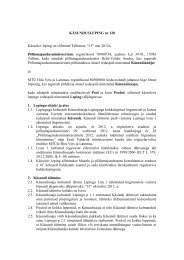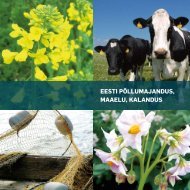estonian agriculture, rural economy and food industry
estonian agriculture, rural economy and food industry
estonian agriculture, rural economy and food industry
Create successful ePaper yourself
Turn your PDF publications into a flip-book with our unique Google optimized e-Paper software.
9.<br />
According to the plan for<br />
the reorganisation of the<br />
supervisory agencies that<br />
was prepared by the committee<br />
set up at the Ministry<br />
of Agriculture, the Veterinary<br />
<strong>and</strong> Food Board supervises<br />
1,340 <strong>food</strong> h<strong>and</strong>ling<br />
enterprises, including<br />
826 enterprises h<strong>and</strong>ling<br />
non-<strong>food</strong> products, which<br />
have been transferred from<br />
the area of supervision of<br />
the Health Protection<br />
Inspectorate.<br />
Control samples taken in the course of supervision<br />
are analysed in laboratories authorised for<br />
that purpose.<br />
Seventeen laboratories hold the rights of authorised<br />
laboratories, which perform all the necessary<br />
control analyses of <strong>food</strong>stuffs: from determining<br />
<strong>food</strong> ingredients <strong>and</strong> nutritional value to testing for<br />
the presence of pathogenic micro-organisms.<br />
The authorising of laboratories ensures the<br />
objectivity of supervision <strong>and</strong> that analysis results<br />
can be compared with the respective indicators of<br />
other countries.<br />
The Estonian phytosanitary supervisory organisation<br />
was restructured in 1998 <strong>and</strong> two independent<br />
institutions were established: the Plant<br />
Protection Inspectorate (PPI) <strong>and</strong> the Control<br />
Centre of Plant Production (CCPP).<br />
The laboratories of the CCPP are supplied with<br />
modern equipment <strong>and</strong> testing methods conforming<br />
to the European Union requirements. Training of<br />
the personnel continues.<br />
The CCPP is comprised of the following units:<br />
Seed control laboratory, accredited by the Seed<br />
Testing Association at the end of 2000 <strong>and</strong><br />
conforming to the EU requirements;<br />
Cereals <strong>and</strong> plant production laboratory,<br />
analysing the quality of concentrated fodder, raw<br />
material of feedstuffs, cereals, cereal products, oil<br />
crops, vegetables, <strong>and</strong> potatoes;<br />
Contaminants <strong>and</strong> residues laboratory, analysing<br />
pesticide agents, pesticide residues, mycotoxins,<br />
trace elements <strong>and</strong> toxic elements in plant products;<br />
the laboratory participates in pesticide residues <strong>and</strong><br />
mycotoxins monitoring programmes;<br />
Agrochemistry laboratory, performing chemical<br />
<strong>and</strong> technical analyses of mineral <strong>and</strong> organic<br />
fertilisers, growth substrates <strong>and</strong> field soils;<br />
Plant health control laboratory, performing<br />
analyses for identifying plant diseases <strong>and</strong> pests<br />
subject to quarantine;<br />
Vilj<strong>and</strong>i Variety Protection Centre with experimental<br />
stations in Saku, Võru, <strong>and</strong> Tori. The<br />
Variety Protection Centre acts in compliance with<br />
OECD <strong>and</strong> UPOV requirements.<br />
Estonia was free from dangerous animal diseases<br />
in 2000.<br />
Estonia was free from infectious animal diseases<br />
designated as especially dangerous – the A-list<br />
diseases.<br />
Bovine herds were free from foot <strong>and</strong> mouth<br />
disease, BSE, tuberculosis <strong>and</strong> brucellosis. There<br />
were single cases of enzootic bovine leucosis, which<br />
did not affect the general leucosis-free status of<br />
herds. The national disease prevention programme<br />
for ensuring the disease-free status of bovines in<br />
artificial insemination continued.<br />
Pig herds were free from foot <strong>and</strong> mouth<br />
disease, classical swine fever, brucellosis <strong>and</strong> other<br />
dangerous diseases.<br />
Sheep <strong>and</strong> goat herds were free from brucellosis<br />
<strong>and</strong> other dangerous diseases. Maedi-Visna antibodies<br />
were detected in 277 sheep (of the 1,288 sheep<br />
studied). The disease was not clinically diagnosed.<br />
Poultry flocks were free from fowl plague <strong>and</strong><br />
Newcastle disease.<br />
Rabies was detected in 130 animals, chiefly wild<br />
animals (the number of domestic <strong>and</strong> farm animals<br />
was 36).<br />
Due to the disease-free status, no damages<br />
occurred <strong>and</strong> no restrictions were imposed on trade<br />
in animals due to diseases.<br />
A framework of disease prevention measures<br />
was established by the Infectious Animal Disease<br />
Control Act <strong>and</strong> the necessary infectious animal<br />
disease legislation was entered into force in 2000.<br />
In 2000, the Border Service of the Veterinary<br />
<strong>and</strong> Food Service detained 744 shipments of goods<br />
at border inspection posts in the course of supervision.<br />
The main reason for detention was the noncompliance<br />
of the accompanying documents of the<br />
goods to the applicable requirements. Meat <strong>and</strong><br />
meat products <strong>and</strong> fish <strong>and</strong> fish products were the<br />
main products being detained; 4,077 tonnes of<br />
goods were returned to the country of origin due to<br />
non-compliance of the goods or the accompanying<br />
documents to requirements, as well as non-compliance<br />
with transportation requirements. In terms of<br />
volume, more than a half of the returned goods<br />
originated in Russia.<br />
32


